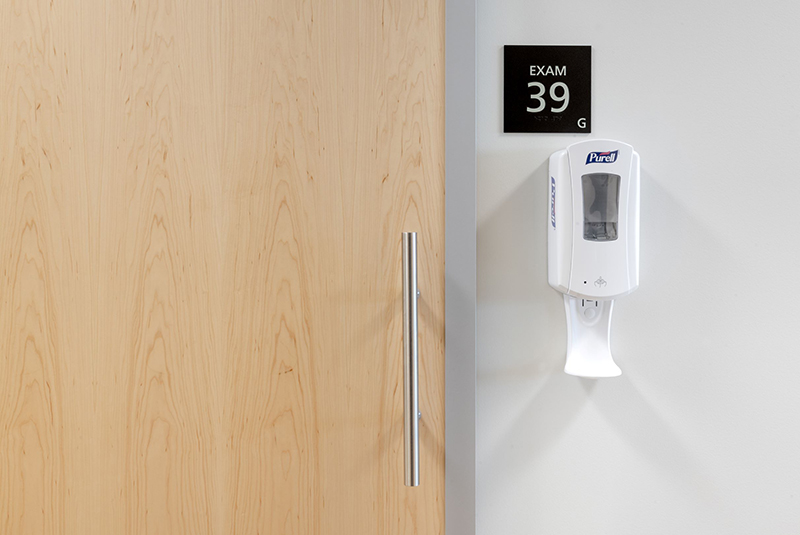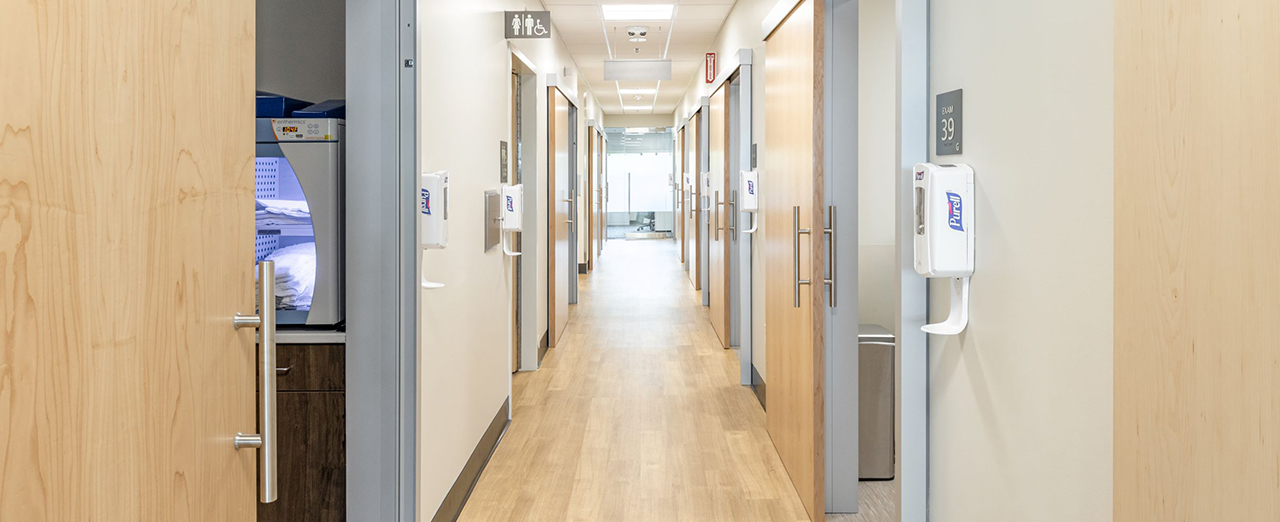
Hospital room doors can contribute to these design considerations both directly and indirectly. In particular, commercial sliding doors and swing doors with flexible opening widths can help designers incorporate the findings from this study as well as improve patient comfort and provider efficiency.
Space-efficient and accessible hospital room doors support patients and providers
As the study suggests, single occupancy hospital rooms can lead to better patient recovery outcomes. To have more single occupancy options available (even during patient surges), maximizing patient room number is essential. Often, designers have two routes to achieve this goal: enlarge the building footprint or utilize space as efficiently as possible. If they choose the latter, hospital room doors can be integral to ensure a design that is space-efficient without sacrificing navigability and accessibility.
For example, commercial sliding doors can save up to 30 square feet per door by eliminating swing arc trajectories. As such, when used in entries, if allowable by code, or as doors to patient restrooms, sliding doors can allow smaller hospital rooms that are still accessible and store all necessary equipment and supplies. In fact, PacMed discovered these doors saved enough space that they were able to add an extra room for every 11 planned. When sliding doors are precluded by code, swing doors with flexible openings can be an efficient alternative for a hospital room door.
Both options also support room accessibility. Shrinking swing arcs also reduces approach clearances, allowing for easier operation for patients using mobility assistive devices. Further, because both sliding and swing door options are available with opening widths and hardware compliant with the standards outlined in the Americans with Disabilities Act (ADA), they can ensure most patients and providers can operate the doors with little difficulty.
Premium acoustic performance gives privacy and ensures comfort
Quiet and peaceful patient rooms can both increase a patient’s comfort level and contribute to a better recovery. By limiting noise transfer both into and out of rooms, designers can preserve patient privacy and ensure an environment that prioritizes rest.
However, hospital room doors can be a weak point in efforts to acoustically isolate spaces. Due in part to perimeter and drop-down seals, select doors can provide Noise Isolation Class (NIC) ratings up to 39. These options dampen sound by 39 decibels, effectively turning outside conversation into a whisper. This improves a patient room’s ability to provide a tranquil space for recovery.
Hospital room doors with full-lite glazing may improve patient outcomes
As the University of Michigan study indicated, when patient rooms have direct lines of sight to clinicians, their occupants have a higher likelihood of recovery. This is because medical professionals can check on them more frequently and quickly provide aid should the need arise. It can also mean that care providers can adjust room settings to promote a more comfortable environment.
Hospital room doors that incorporate full-lites of transparent glass can contribute to visual connection between patients and staff without sacrificing acoustic privacy. While visual connection can be important, it is equally important to provide patients with hospital room doors that preserve visual privacy. Sliding and flexible opening swing doors can be specified with frosted glazing, switchable privacy glass and integral blinds to balance both concerns. These options allow patient rooms to adapt to the particular and shifting needs of an individual.
Restroom doors can be essential for patient autonomy
When a patient room includes a restroom, specifying the right hospital room door can also be difficult because these tend to be very small spaces with large clear openings desired. By eliminating swing arcs, commercial sliding doors sideline the risk of a collapsed patient blocking entry to support care in the event of an emergency. But this is not their only benefit. Top-hung sliding doors do not require floor tracks, making them more accessible. Further, they can be customized with barrier-free openings, allowing for the use of bed lifts for ease of use by patients and providers.
These hospital room door options also give patients more autonomy during recovery periods. On the one hand, barrier-free sliding doors can help a patient feel more in charge of their body. On the other, since patients may not require the supervision of medical personnel to use the restroom, it frees up these providers to spend more time with other patients, potentially improving outcomes for others as well.
How else can hospital room doors support healthcare design?
While the University of Michigan study focused on only three aspects of hospital room design and how they impacted patient outcomes, the researchers acknowledged that there is a gap in our understanding as to all the ways architecture can influence clinical care. Sliding doors can help designers meet some of the design criteria listed in the study directly and indirectly. They can also contribute to more flexible and accessible healthcare settings in general.
Whether they are sliding or flexible swing doors, the right hospital room door can provide several tangible benefits to healthcare operations and patient comfort. How to specify the right system is as variable as the projects themselves—there is almost no one-size fits all door assembly for healthcare settings. In light of that, choosing a manufacturing capable of providing several types of doors (and customizations) can help meet the various needs of most healthcare projects.







